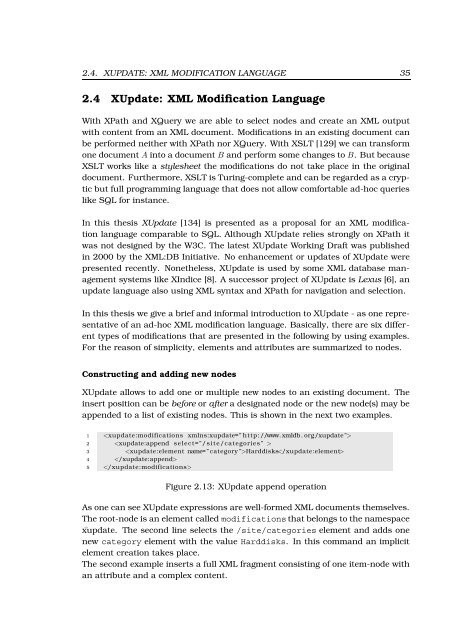url - Universität zu Lübeck
url - Universität zu Lübeck
url - Universität zu Lübeck
Create successful ePaper yourself
Turn your PDF publications into a flip-book with our unique Google optimized e-Paper software.
2.4. XUPDATE: XML MODIFICATION LANGUAGE 35<br />
2.4 XUpdate: XML Modification Language<br />
With XPath and XQuery we are able to select nodes and create an XML output<br />
with content from an XML document. Modifications in an existing document can<br />
be performed neither with XPath nor XQuery. With XSLT [129] we can transform<br />
one document A into a document B and perform some changes to B. But because<br />
XSLT works like a stylesheet the modifications do not take place in the original<br />
document. Furthermore, XSLT is Turing-complete and can be regarded as a cryptic<br />
but full programming language that does not allow comfortable ad-hoc queries<br />
like SQL for instance.<br />
In this thesis XUpdate [134] is presented as a proposal for an XML modification<br />
language comparable to SQL. Although XUpdate relies strongly on XPath it<br />
was not designed by the W3C. The latest XUpdate Working Draft was published<br />
in 2000 by the XML:DB Initiative. No enhancement or updates of XUpdate were<br />
presented recently. Nonetheless, XUpdate is used by some XML database management<br />
systems like XIndice [8]. A successor project of XUpdate is Lexus [6], an<br />
update language also using XML syntax and XPath for navigation and selection.<br />
In this thesis we give a brief and informal introduction to XUpdate - as one representative<br />
of an ad-hoc XML modification language. Basically, there are six different<br />
types of modifications that are presented in the following by using examples.<br />
For the reason of simplicity, elements and attributes are summarized to nodes.<br />
Constructing and adding new nodes<br />
XUpdate allows to add one or multiple new nodes to an existing document. The<br />
insert position can be before or after a designated node or the new node(s) may be<br />
appended to a list of existing nodes. This is shown in the next two examples.<br />
1 <br />
2 <br />
3 Harddisks<br />
4 <br />
5 <br />
Figure 2.13: XUpdate append operation<br />
As one can see XUpdate expressions are well-formed XML documents themselves.<br />
The root-node is an element called modifications that belongs to the namespace<br />
⁀xupdate. The second line selects the /site/categories element and adds one<br />
new category element with the value Harddisks. In this command an implicit<br />
element creation takes place.<br />
The second example inserts a full XML fragment consisting of one item-node with<br />
an attribute and a complex content.
















